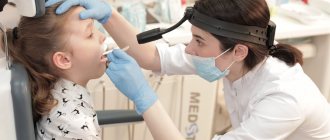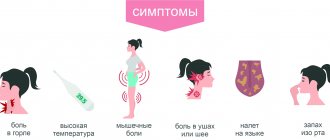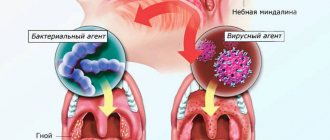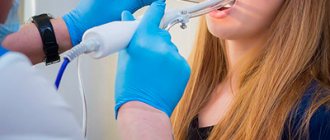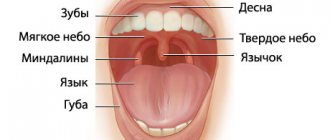Chronic tonsillitis is a process that is quite difficult to deal with, because often its signs are ignored or simply not noticed by patients, and doctors rarely pay due attention to it - until the patient himself begins to complain of feeling unwell. During exacerbations of the disease, a course of antibacterial agents is usually prescribed, and with a short “experience” of the disease, they help well. However, over time, the effectiveness of antibiotics decreases, and often those drugs that suppressed the growth of microbes during the first attacks cease to have any effect in the future. What explains this?
Washing methods
This procedure must be carried out carefully, it is better to have it done by a specialist, since with the wrong approach you can aggravate the situation up to the development of sepsis, driving the inflammatory process even deeper or damaging soft tissues.
Washing of the lacunae of the tonsils is carried out in the following ways:
- Using a syringe for intralaryngeal infusions and rinsing of the tonsils.
- Vacuum rinsing of tonsils with the Tonsilor apparatus.
- Deep rinsing using phonophoresis and ultrasound.
Are there any complications?
Despite the fact that washing the lacunar cavities is one of the most effective and safe techniques, sometimes patients experience adverse reactions. List of common complications:
- Tissue damage. Irritation and microtrauma of the epithelium cause painful sensations when swallowing. This happens when the procedure is performed by an inexperienced doctor or due to accidental movements of the patient.
- Allergic reactions. After washing out the purulent plugs, the cavities are treated with an antiseptic. If you have an allergy, there may be a local reaction: redness and swelling of the tonsils, or a general reaction, manifested by skin rashes and nasal congestion. If you are allergic to an antiseptic, replace the product.
- Spread of infection. During the leaching process, the contents of the lacunar cavities can get onto nearby mucous membranes and cause inflammation of the nasopharynx, pharynx or respiratory tract.
- Exacerbation of chronic diseases. The mechanism of the pathology is not fully understood, but it is assumed that an exacerbation is provoked by a local decrease in immune defense, when leukocytes are washed out of the lacunae along with pus. A person’s temperature rises, sometimes up to 40°C, weakness appears, and the lymph nodes become enlarged. In case of exacerbation, the course of therapeutic lavage is interrupted until the patient’s condition improves, and then the procedures are continued.
Most often, when washing the lacunar folds, microdamages occur in children and suspicious patients who, despite anesthesia, have difficulty sitting still. Other complications are relatively rare.
Flushing with a syringe
This method can be offered in any clinic. It is considered painless and lasts about 10 minutes. The patient is seated and asked to open his mouth. A cannula is attached to the syringe. The surface of the pharynx is treated with a solution of local anesthetic. They do this to reduce discomfort during manipulation.
After this, the cannula of the syringe is inserted into the cavities of the tonsils and their contents are sucked out. This can be pus, microorganisms and their metabolic products, food debris, or liquid. After the procedure, the surface is irrigated with anti-inflammatory solutions.
What are tonsils, structural features
The immune system consists of many components. They participate in the formation of the body’s immune response to pathogenic agents when attempting to introduce them. The tonsils are considered an important part of it. They are accumulations of lymphoid tissue. The tonsils are located in the mucous membrane lining the pharynx. Formations become the first filter on the path of infection into the body.
Together with other accumulations of lymphoid tissue, they form the pharyngeal ring. Tonsils have a complex structure. They are pierced by winding deep channels called crypts. Branching reaches the third or even fourth order. Their number is usually from 16 to 18 pieces. The epithelium covering the walls of the crypts is associated with lymphoid tissue over a large area.
These formations are most developed in the area of the upper pole of the tonsil. In their lumen, desquamated epithelial cells, food debris, leukocytes, and lymphocytes accumulate. Bacteria actively multiply in this environment. This structure promotes the development of chronic inflammatory processes inside the crypts.
Vacuum rinsing of tonsils
Modern otolaryngological offices carry out rinsing of the tonsils with Tonsilor - a special device that carries out cleaning using ultrasound and antiseptic solutions.
It quickly helps to achieve the desired result and has the following effect after use:
- anesthetic;
- antibacterial and antifungal;
- increases local immunity;
- restores normal microflora on the surface of the tonsils.
How to rinse your tonsils with an oral irrigator
To rinse your tonsils using an irrigator without harm to your health, you must follow the rules of the procedure. The algorithm looks like this:
- The irrigator reservoir is filled with water or a disinfectant solution and the device is plugged into an outlet.
- Set the jet pressure - it is recommended to first select the lowest pressure in order to gradually increase it later.
- The tip of the irrigator is inserted into the throat and the device is turned on for 20-30 seconds.
- After processing one area, turn off the device, change the position of the device and put the device into action again.
When washing the tonsils with a water jet, many people experience the urge to nausea. Therefore, before the procedure, it is advisable not to eat or drink for 1.5-2 hours. To make clearing your tonsils less unpleasant, you need to breathe smoothly and steadily through your nose.
Washing of the tonsils is carried out in courses. The procedure is performed daily for 5-10 days, and then take a break for several months.
Rinsing the tonsils should be done in front of a mirror - this will allow you to better control the process
What liquid should you wash your tonsils with?
Cleaning the tonsils with an irrigator is carried out using not only water, but also antiseptics. Several solutions are popular:
- furacilin - two tablets of the drug are diluted in 250 ml of warm water and infused for 30 minutes;
- salt - stir 5 g of table or sea salt into 200 ml of liquid;
- chlorophyllipt - the drug is diluted with water in a ratio of 1:5.
Herbal decoctions and infusions also have good disinfectant properties. However, it is not recommended to pour them into the irrigator - this can cause the device to become clogged from the inside and fail. Herbal remedies are best used for routine preventive rinsing of the mouth and throat after meals.
Warning! You should not swallow the solution after cleaning the tonsils with an irrigator, since the purulent contents removed from the tonsils will then end up in the stomach.
Contraindications to washing with hardware methods
Despite such a positive effect from hardware methods, in some cases this method cannot be used. These include:
- Retinal detachment.
- Hypertension in stage 3 or 2B.
- 1st and third trimester of pregnancy.
- Acute forms of infectious diseases.
- Oncopathology.
- Atherosclerosis of coronary or cerebral vessels.
- Active tuberculosis.
- Disorders of the autonomic nervous system.
- Pathology of the respiratory and cardiovascular systems in the stage of decompensation.
Methods for treating inflammation of the tonsils
Chronic tonsillitis is usually treated using conservative and surgical methods, which are used only as a last resort.
The following types of therapy are used:
- antibiotic therapy prescribed by otolaryngologists taking into account the sensitivity of bacteria; treating the throat with antiseptic solutions (“Octenisept”, “Miramistin” and others); antihistamines to relieve swelling of the mucous membrane; immunomodulators to stimulate the immune system; painkillers.
The patient must strictly follow a diet. Exclude solid foods, cold or hot dishes and drinks, alcohol, soda.
Washing tonsils at home
If you have tonsillitis, you can rinse your tonsils at home. Someone close to you can help you with this, or do everything yourself. To begin, prepare a saline or furatsilin solution and thick cotton swabs. Soak the latter well with the resulting liquid and then wash the affected lacunae with light pressure. Repeat the action several times.
Those who know the exact location of the organ can manipulate it using a syringe. The needle is then removed. To use this method, you need to have certain skills.
What methods are used
The purpose of flushing is to remove the purulent exudate accumulated in the tonsils. This is done using liquid or vacuum. Methods used:
- With a syringe. Rinsing with a syringe is one of the simplest and most accessible ways to clean the cavities of the lacunae. The slight pressure of a stream of antiseptic liquid, created by pressing the piston, breaks the plugs and removes accumulations of pus. After washing the solution, the person spits it out.
- Vacuum. The Tonzillor-MM device is used. The vacuum method is more effective. The plugs are crushed by ultrasound and “sucked out” using a vacuum. Using the method allows you to achieve complete cleansing of the lacunae and ensure deep penetration of drugs into the tonsil tissue. The use of a vacuum allows you to avoid the spread of infection to nearby mucous membranes.
- Cavitation and ultrasound. The technique is based on the creation of a micro-shock wave. When passing through the treatment solution, ultrasound forms small bubbles that burst inside the lacuna, creating a shock wave. Washing is performed with the UZOL device. A new technique that is almost twice as effective as other methods, but not all clinics have the equipment.
Hardware flushing is performed under local anesthesia. When using a syringe, no anesthesia is required. But if a person experiences pain and discomfort, then the tonsils are irrigated with an anesthetic.
Frequently asked questions related to the procedure
- How many treatments are needed? To get rid of tonsillitis you need to undergo 5-10 procedures. The specific number is determined by the doctor depending on the extent of the inflammatory process.
- Is pain relief provided? Although irrigation is carried out without a needle, local anesthesia is still used. They do this to reduce discomfort during manipulation.
- How to prepare for the procedure? Preparation consists of refusing to eat at least an hour before the upcoming wash.
- How often should you rinse your tonsils? The need for the procedure depends on the activity of the disease and the rate of accumulation of fluid, food particles, and bacteria in the lacunae. Only the attending physician can determine the frequency of washing. At least once a day.
- How long should I rinse my tonsils? Even if during a single procedure it was possible to completely remove the contents of the lacunae, the manipulation will have to be repeated at least 7-10 more times, it is better to do it every day. This is due to the constant proliferation of pathogenic microflora. And this approach will allow you to achieve stable remission.
- Are there any special features of oral hygiene during the course of treatment? During the course of treatment after each procedure, it is prohibited to eat for the first two hours. It is also worth giving up solid food during this period, since after eating it, a piece may get stuck in the passages.
Thus, washing the tonsils for tonsillitis is an effective treatment method. But if carried out incorrectly, a serious complication can develop, so it is better to contact a specialist.
Is it possible to rinse the tonsils with a dental irrigator?
Many people suffer from chronic tonsillitis, a disease in which purulent plugs form in the lacunae of the tonsils, regularly causing inflammation and sore throat. Cleansing the tonsils in a hospital setting requires extra financial costs. However, the effect of the procedure lasts only for a short period.
If there are no contraindications, you can rinse your tonsils at home. You can use a regular dental irrigator, provided that it meets certain requirements. If you are careful and do not violate the rules of the procedure, cleaning will help prevent bacterial processes in the lacunae and protect against exacerbations of tonsillitis.
Rinsing the tonsils with an irrigator not only prevents sore throat, but also improves overall immunity
Advantages of treatment at an ENT center
Treatment of ear, nose and throat diseases at the ENT CENTER is a comprehensive and individual approach to each patient. By making a preliminary appointment on the medical center’s website or by phone, you can:
- get face-to-face consultation with a specialist;
- undergo treatment of ENT diseases using progressive techniques;
- receive recommendations for further conservative treatment and prevention of ENT diseases.
Contact the ENT CENTER : here they will help you solve any problem within the competence of ENT doctors as efficiently, safely, quickly and painlessly as possible.
What is the reason for this difference in approaches in the practice of Russian doctors and their colleagues from other countries?
First of all, the criteria on the basis of which the diagnosis of chronic tonsillitis is made are very different. In Russian medical practice, this diagnosis is often made based on an examination of the throat, even without assessing the patient’s history. In the practice of doctors from European countries, Japan, and the USA, such a diagnosis is rarely made, and based on a number of signs.
Patients who have been diagnosed with this can often hear about a “locus of chronic infection”, the risk of developing other diseases due to the fact that dangerous bacteria spread from the palatine tonsils to other organs and systems. Today this medical concept is outdated. Numerous studies and meta-studies have shown that only one disease has a risk of spreading beyond the tonsils - tonsillitis or, in scientific terms, “streptococcal acute tonsillitis”.
Sore throat is a disease caused by certain bacteria that are easily transmitted from person to person. If a patient suffers from tonsillitis more than 2-3 times a year for several years, the tonsils need to be removed. This is the only measure that, from the standpoint of modern science, can help the patient in this situation and negate the risks of developing other diseases.
Rinsing the tonsils does not reduce the risk of developing tonsillitis.
What is the Tonsillor device?
"Tonsillor - 3MM" is used for the conservative and surgical treatment of diseases of the ENT organs through the combined effects of ultrasound, vacuum and ozone/NO-containing medicinal substances on the affected tissues.
Ultrasound, which has healing properties, allows for anti-inflammatory and resorption therapy, pain relief, improves blood microcirculation at the site of exposure, cleans wounds of necrotic tissue and bacterial contamination and creates a drug depot at the site of the lesion. Under the influence of ultrasound, trophism, blood supply to tissues, metabolism improve, and local immunity is stimulated.


